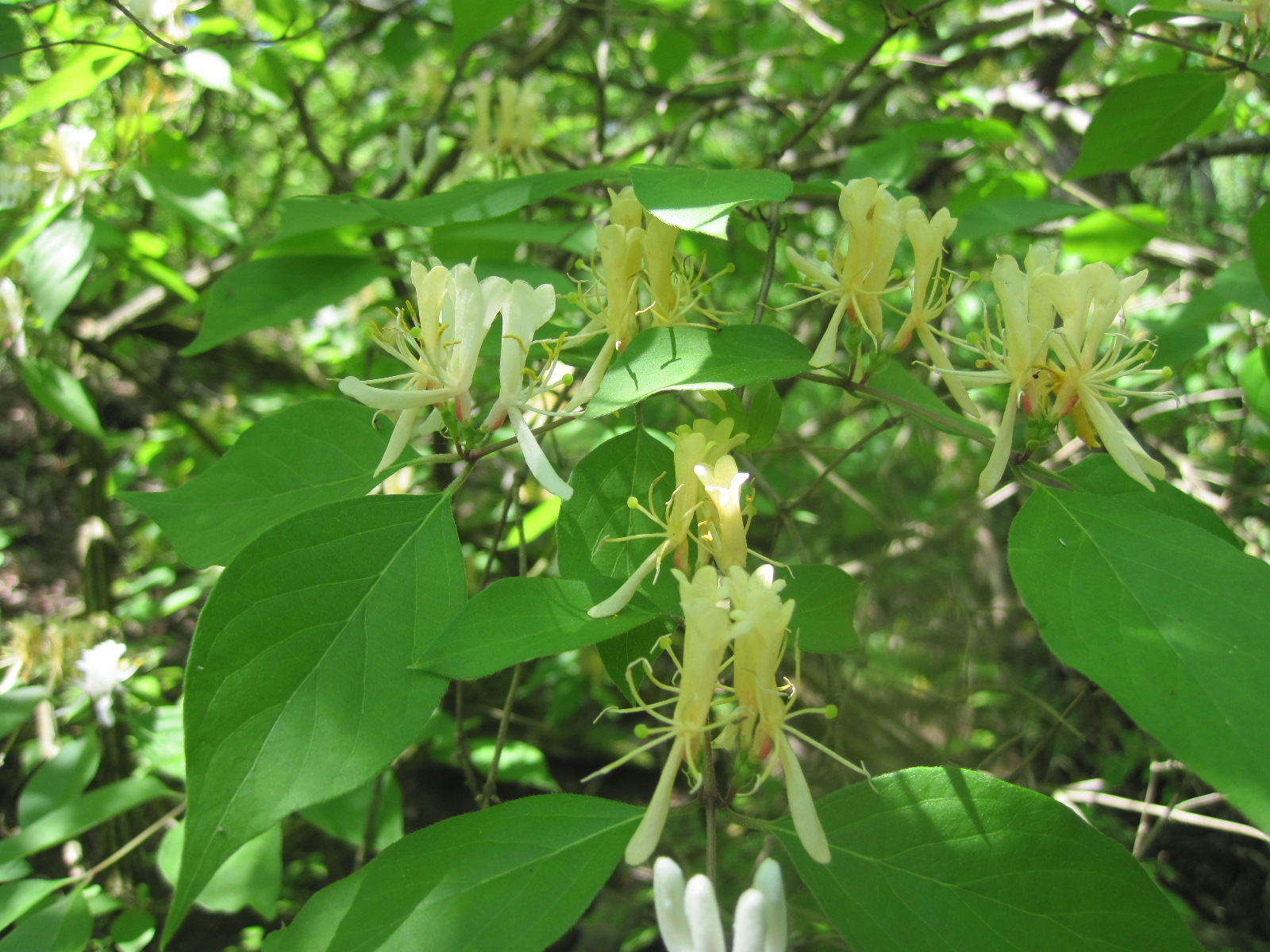 Plant Biology
Plant Biology
From forests to streams: How one plant can make a difference
Amur honeysuckle, an invasive plant in the United States, is able to cause drastic changes within invaded ecosystems. Management practices might reduce these effects which could impact not only terrestrial ecosystems but aquatic as well.

Did you ever try the nectar of a honeysuckle flower as a kid? Maybe you have memories of plucking the numerous, small, white and yellow flowers from the bush's branches to get at that single drop of sweetness inside each one. If these plants were in your yard and left to their own devises, you may even have watched them grow over the years into full-blown hedges taller than you. Imported from Asia for its beauty and functionality, Amur honeysuckle (Lonicera maackii) has since outgrown its humble beginnings and is now classified as an invasive organism in the United States. That is, a non-native species that can influence entire ecosystems and negatively impact human and wildlife health. One way invasive species can impact ecosystems is by outcompeting and replacing native species. We've seen this in the terrestrial world. If you were to drive along almost any highway in the upper Midwest, USA, and look at what's growing under the trees, you'd probably see a near monoculture of honeysuckle shrubs. This is also true along river and stream banks, an area known as the riparian zone. Riparian zones act as bridges between terrestrial and river habitats by sharing nutrient and energy resources (think leaves falling into the stream or blocking sunlight). So, although it is a terrestrial plant, Amur honeysuckle has the potential to impact local aquatic environments too.
Armed with this knowledge, land managers have implemented management practices in an attempt to remove and eradicate invasive honeysuckle. In fact, the propagation of Amur honeysuckle is controlled and even banned in some states in an effort to control the spread of this species. Great efforts have been taken to manage the removal of, and understand the impact of, invasive species; however, sometimes these management practices can have unintended impacts.
To tease this out further, we decided to study the connection between riparian zones invaded by Amur honeysuckle and their nearby streams. We knew from previous work that the invasion of Amur honeysuckle into riparian zones changes the resources available to organisms living in streams. The shrub can create dense leaf and branch cover that overarches streams, acting as a net collecting leaves falling from the taller trees above. These falling leaves would otherwise serve as habitat and food for aquatic macroinvertebrates, like juvenile insects, snails, and leeches. So, we know the presence of Amur honeysuckle can directly impact individual organisms, but what about the macroinvertebrate community as a whole? Well, we have seen from other research that the aquatic macroinvertebrate communities actively using the Amur honeysuckle leaves as a resource, tend to be different than those that use native leaves, which made us wonder, how will these communities respond if the invasive shrub is removed from the riparian forest? Had these communities come to rely on the honeysuckle or could the plants be removed without influencing these communities?
We conducted our own field experiment by mimicking the common management practice of completely removing the Amur honeysuckle shrub from the riparian zone. This removal effectively changed the lighting, temperature, nutrients, and leaf litter in the stream. We then measured the response of the aquatic macroinvertebrate community to all these changes to see what happened. We found that both the number of species and as well as the number of individual macroinvertebrates present increased one year after honeysuckle removal, and this pattern persisted for at least three years. Also, not only did the abundance of macroinvertebrates increase, but the players changed too. Several new predator and herbivore (algae/plant-eating) species showed up in the community that had not been there before.
These changes in who was there - gain of new species - ultimately changes the functional aspect of the community - species roles/jobs. Such changes can impact important ecosystem processes, such as nutrient cycling and decomposition that influence the entire stream ecosystem! All because of one plant.
So, is it worth the time and effort to remove the Amur honeysuckle growing in your backyard? Well, how much do you enjoy that single drop of sweetness inside each flower? Although we have a better understanding of how forest management practices and invasive plants can impact streams, we still have not come full circle. In other words, how do forest management practices and invasive plants impact the flow of resources from the stream back to the forest? Does an increase in a stream, juvenile, insect biodiversity mean the biodiversity of their adult, terrestrial counterparts - such as mosquitos and dragonflies - are impacted as well? With these questions in mind, it is clear there is still much work that needs to be done.
Original Article:
R. E. McNeish, M. E. Benbow, R. W. McEwan, Removal of the Invasive Shrub, Lonicera maackii (Amur Honeysuckle), from a Headwater Stream Riparian Zone Shifts Taxonomic and Functional Composition of the Aquatic Biota. Invas Plant Sci Mana 10, 232-246 (2017)Next read: Ships with hitchhiking critters connect Antarctica to the rest of the world by Arlie McCarthy
Edited by:
Massimo Caine , Founder and Director
We thought you might like
More from Plant Biology
Unravelling the Secrets of Pine Roots: A Tale of Nutrition and Adaptation
Oct 20, 2023 in Plant Biology | 3.5 min read by Rafael Cañas , Francisco OrtigosaStressful memories help plants resist caterpillars
Oct 2, 2023 in Plant Biology | 3.5 min read by Samuel Wilkinson , Adam Hannan Parker , Jurriaan TonDecoding the genome of a jackfruit that grows all year round
Sep 6, 2023 in Plant Biology | 3.5 min read by Tofazzal IslamLife after logging: the tale of recovering tropical forests
Aug 21, 2023 in Plant Biology | 3.5 min read by Maria Mills , Terhi RiuttaEditor's picks
Trending now
Popular topics


